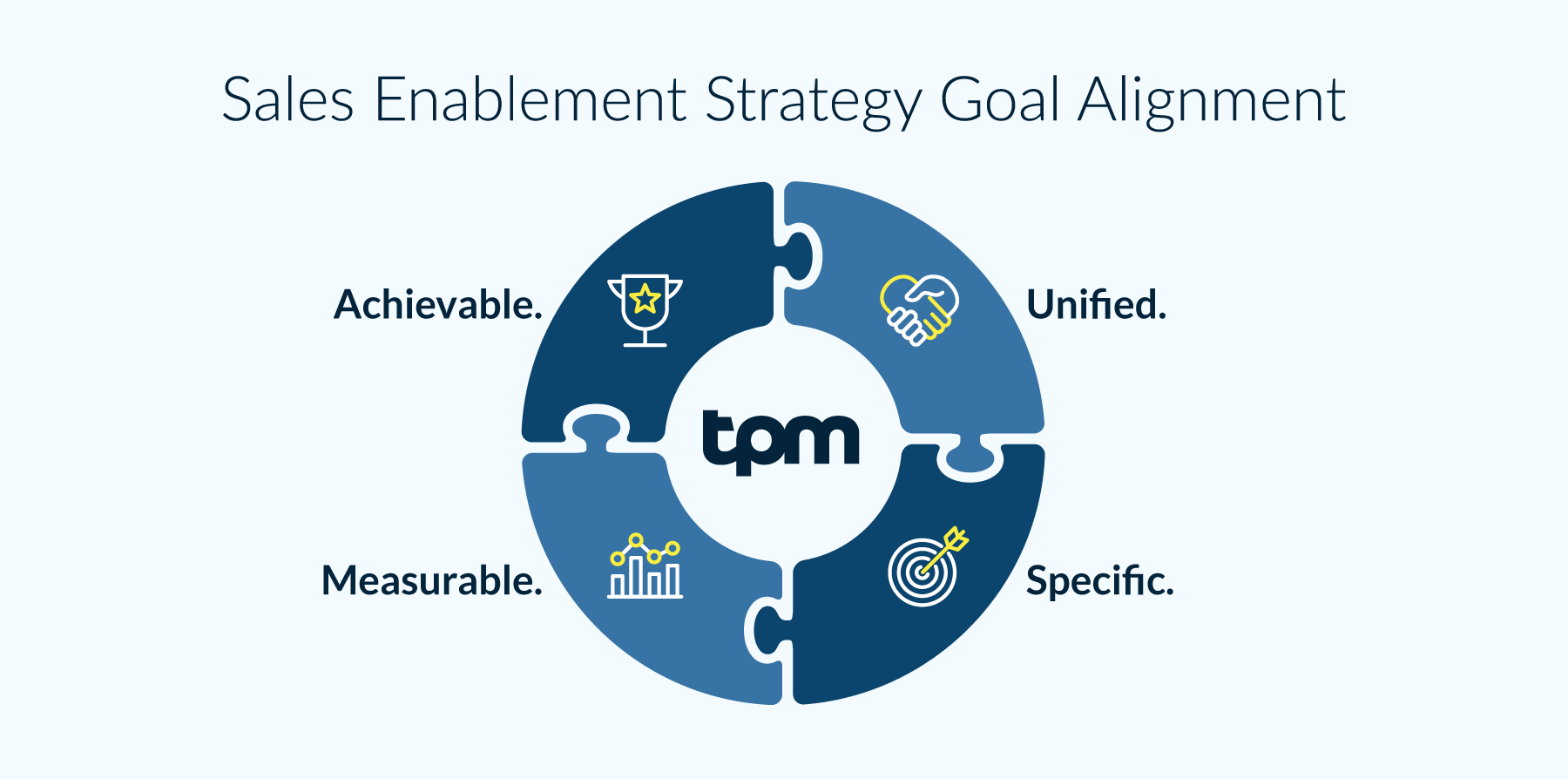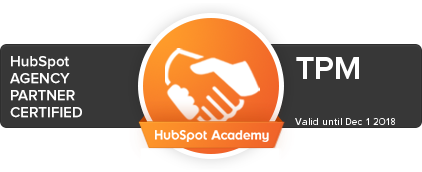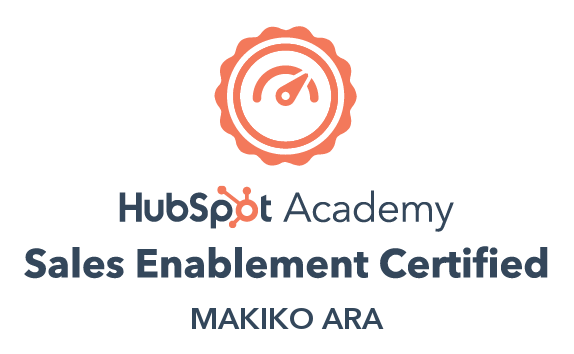There’s no doubt the pathway to building an effective sales enablement strategy is an involved process. There are several key processes, tools, and stakeholders involved — all needing to come into alignment with your buyer.
But think of the payoff. A high-performing sales enablement program can optimize the sales process, streamline workflows, inspire collaboration, and deliver a personalized customer experience.
With careful planning and a well-executed strategy, your efforts will pay off. 97% of brands with a formal sales enablement strategy said it has increased the overall success of their company’s sales performance.
To build your own B2B sales strategy from the ground up, let’s explore some best practices that will set your organization up for success.
5 Key Elements for a Successful Sales Enablement Strategy
1. Align Your Teams on a Clear Goal (and it’s OK if these goals change!)
With sales enablement sitting between sales, marketing, human resources, and customer success, all stakeholders need to agree on a clear goal. When setting up a sales enablement strategy for the first time, it is advisable to set realistic goals.

Whether your goal is a new product launch or a specific dollar amount of revenue, your goals should be:
- Unified. Come up with a goal that all stakeholders are excited about — what do they want? Building your goals as a team makes individuals more accountable and can boost morale.
- Specific. Vague goals are obstacles to your growth. Narrow down the Who, What, Where, Why, and When of your desired outcome.
- Measurable. Quantifying your goals makes it easier to know how your sales enablement efforts are paying off.
- Achievable. Goals are meant to move us forward and upward. If you are aiming high, consider breaking down your vision into smaller micro goals.
Revenue is one way to measure the effectiveness of your sales enablement efforts. It is a common language across all stakeholders so it facilitates collaboration not competition.
There are other metrics you can use to measure the impact of your efforts:
- Uptake of sales enablement content
- Increase in social selling metrics
- Decrease in average sales cycle length (i.e., time from lead engagement to close)
- Decrease in onboarding time
- Increase in average deal size, just to name a few.
The success of your B2B sales strategy will be directed in many ways by data. It is best practice to keep a close eye on metrics and key performance indicators.
But don’t get caught up in choosing the ‘best’ goal. Be flexible, be realistic. Just get started!

2. Focus on the Behavior of Buyers Most Likely to Buy from You?
How do you focus on leads most likely to buy from you? You nail down your target buyer with precision. Let’s face it, you can’t be everything to everybody. You need to maximize your time spent with the right buyers and minimize time spent on the wrong ones.
This can be done through lead scoring, the process of scoring ideal customer demographics and behaviors to determine sales qualification. Inbound leads who are educated are good sales-qualified leads (SQLs) because they understand the pains your solution solves, and have invested significant time in the process — making them more likely to buy. Lead scoring helps you identify those individuals.
In your sales enablement strategy, sales and marketing teams need to have a shared understanding of what a qualified lead is — they need to build their target buyer definition together.
To clearly define your target buyer, work from a messaging and brand positioning methodology like the one we have developed for tech companies. Ask yourself:
- Who is the ideal customer for your solution?
- Who is the primary buyer persona?
- What is the ideal market segment?
Ideal customer profiles (ICPs) identify a broad category of people. Buyer personas are a subcategory of your ideal customer, essentially a semi-fictional representation of your ideal customer.
For example, in a typical B2B space your ideal customer will define which companies are a good fit for your offering. Your buyer personas are the people at those companies you need to work with.
Write your own extraordinary brand positioning strategy by using TPM’s XYZABC Approach.
3. Change the Way Your Company Thinks About Content
Content is a crucial component of a sales enablement strategy. Typically content lies in the domain of marketing departments, but sales creates more content through emails, videos, and presentations at a much larger scale than marketing.
As more of the buyer journey is self-directed, marketing is being called upon to provide more of the education of prospects. Gartner reports B2B buyers spend only 17% of their time meeting with potential suppliers. This is a great opportunity for sales and marketing to combine efforts to make sales materials available to larger audiences and streamline sales content.
Buyer journey content, often created by marketing, is often not shared with sales. Sales can spend hours looking for or developing content to meet a prospect’s needs — duplicating efforts and wasting valuable time. Often, sales must make do with an asset and tweak it to meet their needs. This results in multiple versions of assets floating around, with mixed messaging, resulting in friction in the sales process, loss of buyer trust, and potentially a lost sale.
Internal structural changes can be made so that content streamlines the sales process and aligns with the new B2B buyer journey.
- Include sales in the feedback process. Once marketing starts working on an asset, they should get feedback from sales.
- Store content in a shared place. Leverage tools like content management systems, sales enablement software, and cloud storage.
- Find out what’s working — and do it to scale. All content needs to be measured for its effectiveness.
- Don’t just create for the sake of creating content. Content creation is purposeful. It’s there to solve a problem or answer a question.

4. Leverage Resources Across the Buyer’s Journey
The best sales enablement strategies shift to creating content for the whole buyer journey. More and more, sales teams have fewer opportunities to influence customer decisions, so you need to meet buyers where they are at.
Content has become increasingly vital as the buyer’s journey becomes more digital. Knowing where to allocate your resources and make investment decisions is key to formulating a content creation strategy that aligns with your buyers. You need to ensure that your organization’s capital is working as hard as it possibly can to streamline the sales process.
“The challenge of resource allocation is determining where the resources will bring the most value, how much money and talent to redistribute, and how to put those shifts effectively into action.”
— Yuval Atsmon, McKinsey & Company
The first step of resource allocation is creating an analytical foundation. This builds a strong case for shifts in resources and is key to overcoming stakeholder resistance and countering biases.
You need to understand your enablement return on investment (ROI). This means:
- Auditing your content
- Identifying which pieces are performing and underperforming at each stage of the journey
- Adapting quickly for better results
Third-party agencies like TPM are another way to keep your enablement efforts on track. This is where an external partner can help take the strain off marketing and ensure sales is staying on message.
5. Nurture Alignment and Collaboration Across Stakeholders
Traditionally, sales and marketing teams have struggled to maintain alignment. Working from opposite ends of the traditional sales funnel, they have butted heads over brand messaging and delivery for a long time. However, modern teams are completely in lock-step — and sales enablement helps with that.
The digital transformation of marketing and sales allows your teams to quickly adapt to the constant changes in technologies, markets, and consumer behavior. Sales and marketing technologies today provide valuable data that prove the value of sales enablement, test theories, optimize content strategies, and verify organizational investment.
It is important to set the expectation that all stakeholders are equally accountable. Yes, in sales enablement the focus is on sales and making the sales team more effective, but it does not mean your organization sits at the feet of sales. All stakeholders need to be contributors and feel comfortable bringing insights to the table.
How Can You Measure The Effectiveness Of Your Strategy?
You have a strategy in place, but at the end of the day you need to know what and how to record so you know it’s effective. Being able to measure the right KPIs and effectively communicate this to your key stakeholders are going to be essential for sales enablement. See our list of Best Sales Metrics to see if your strategy is working for you.
Enjoyed this read?
See our full collection of Sales Enablement blogs to close more deals, faster!



